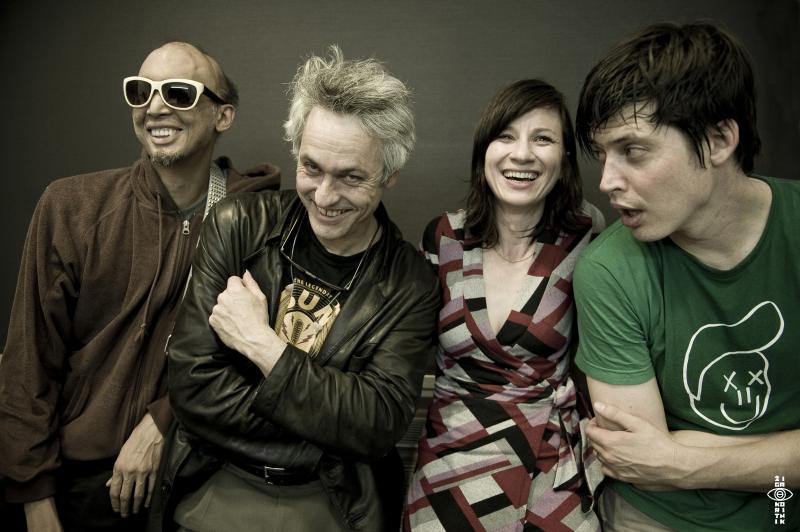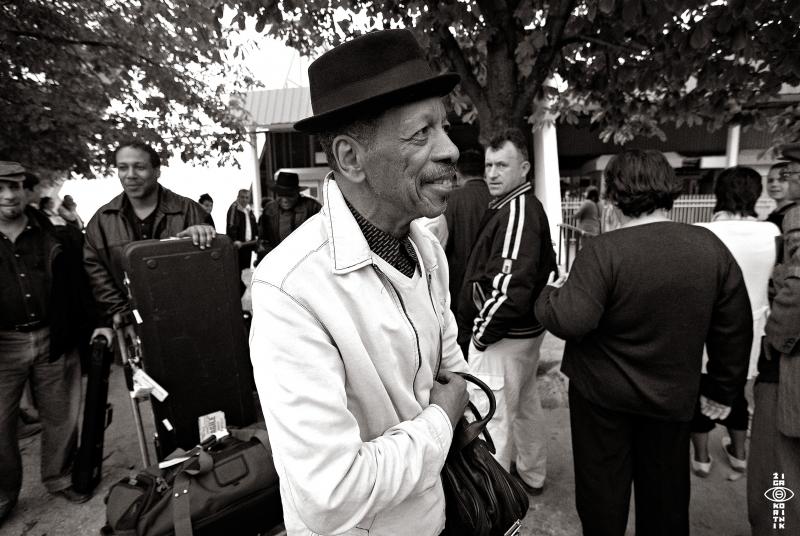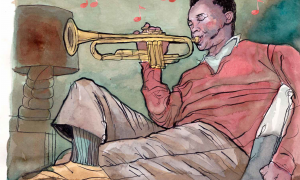Home » Jazz Articles » Jazz Art » Ziga Koritnik and The Eye
Ziga Koritnik and The Eye

Anyone can take a picture but to get to the heart of a subject and truly capture what it's about requires more than a camera and the opportunity to use it. It requires The Eye: one that sees things most don't, sometimes in the most mundane circumstances.
Žiga Koritnik has The Eye. Capturing more than just the image in front of him, Koritnik's eye intuits those special moments in time to which we all aspire, but only rarely achieve. And it's more than mere documentation; anyone with the money and the desire can learn the mechanics of taking a technically proficient photo, just as anyone with the money and the desire can learn to play an instrument. Anyone can, in time, take a good photo; only a precious few can create great ones, and only an even more rarefied handful can fashion a consolidated work of art that tells a story, as Koritnik has done with Cloud Arrangers, a photo book for which Koritnik is currently searching for a publisher.
Telling tales is nothing new for Koritnik. Un punto di luce (Edizione Archivi Delsud, 2009) told the story of the small town of Gavoi, the drum village in the heart of Sardinia. No words were necessary to articulate Koritnik's journey through farm country to Gavoi, or the sights and sounds of a festival all the more remarkable for his using exclusively black and white photography to capture the nuances often lost in color imagery. Still on the shy side of 50, Cloud Arrangers is Koritnik's first book of musical photo impressions, and even more than the singular experience of Gavoi, it's a book he's been working towards his entire life.

"I consider that I am working for the culture; that I am working for the music scene," says Koritnik. "I am supporting it; I am promoting it with my work. I am happy that I can do what I like in my life—making photographs and listening to good music. I like making exhibitions and books. And if, for instance, I make somebody interested in contemporary improvised music with a picture where everyone can see how much work, passion and feelings are inside, then I feel like I have done a good job.
"Music is the best, as Frank Zappa said, and it felt like it was time to clean out the archive, to put all my good pictures together and, with this book, reflect the time I've lived in for the last 25 years," Koritnik continues. "I have heard so much good music, been to so many beautiful places, and met so many nice and beautiful people ... I want to have all those memories in one place.
"I would like to give it to relatives; to people I know (and don't know), to those who share similar interests and feelings when we listen to or start talking about our beloved subject: music," Koritnik concludes. "I wanted to make a well-produced, well-printed and beautifully designed book, to make an album for my musical "family." There are so many music photography books in the field, but I haven't seen any yet, that cover what I have documented through the years."
Everybody's story is unique; everyone's experiences ultimately come together to create who they are. Growing up with a loving family was clearly significant to Koritnik. "I became interested in photography during the first decade of my life on planet earth," the Slovenian-born photographer explains. "I was always surrounded by creative people in the place where I was living. Two of my neighbours were photographers—one of them even a professional cinematographer. There was also, at the time, a very well-known jazz saxophonist. My father was an amateur photographer, as many of his friends were. They would gather at their homes, after their travels, and we'd have slide projection 'shows.'"

Cloud Arrangers is an apt title for a book of images that represents the culmination of Koritnik's hopes and dreams from such a young age. "I liked the sound and heat of the projector, and all the comments that people gave during the 'show,'" he continues. "This triggered my imagination, as did all the advertisements for different cameras I had been dreaming about. Whenever I held a camera in my hands, I dreamed of how it would work—how would be possible to make, with this box, beautiful pictures like those I was admiring at the time—and how great it would be to have one. My first camera was an East German camera, a CERTO KN35, and I can still smell it, though I later demolished it into pieces, as I was interested in how it looked inside."
Koritnik worked at TV Slovenia as a cameraman for 18 years, honing his skills with a camera the way a musician hones his/her chops with an instrument. Growing up in the 1970s—a time when it seemed like anything was possible—it's no surprise that his musical tastes and the influences that ultimately shaped who he is today were so stylistically broad.

"Beyond my neighbourhood, there was Radio Student in Ljubljana," he explains. "They were always broadcasting very interesting and different music. The first time I heard Frank Zappa was on the radio: The Mothers of Invention, Live at Fillmore East (Rykodiosc, 1971). I would sit next to radio and wait to record the shows on tape so I could listen to them afterwards. Initially, I listened a lot of rock music: Jimi Hendrix, Led Zeppelin, the Allman Brothers Band, Yes, Rory Gallagher, Mike Oldfield...and came to the waters of improvisation through Zappa and a 1987 Miles Davis concert in Belgrade. After that, Pat Metheny came to Ljubljana and became a regular guest of the Ljubljana Jazz Festival. And so began a discovery of music that never ends."
Everyone has to have roots, however, and Koritnik cites seminal photographers including Ansel Adams, Annie Leibovitz, Henri Cartier Bresson, Herman Leonard, William Claxton, Peter Beard, Helmut Newton, Richard Avedon and Martin Parr.
Jazz guitarist Pat Martino wrote that you study for years, practice scales, learn harmony, understand rhythm...and then you just forget about it and play. Koritnik has spent plenty of years paying his dues, but from an early time, his eye was already seeing things others didn't, and his approach differed in that it was always about the music. "One of the first shows I ever shot was a Slovenian rock group and a band called Liars," Koritnik recalls. "The place was packed, everybody was smoking and it was so loud I had sound in my ears for another two days. But I was enchanted with the concert atmosphere and all feelings that developed."

While Koritnik's first professional photo shoot was in 1990, "when we were shooting a commercial in Montenegro where, parallel to that, I shot a photo that won a special recognition award at the Olympus International Contest in Japan," the ever-humble photographer still likes to think of his first picture as being "pressing the shutter button on my dad's camera, when I was playing with my irresistible attraction to cameras."
Over the years, Koritnik has shot hundreds—maybe even thousands—of performers, ranging from singers Tom Waits, Cesaria Evora and Dianne Reeves to deep improvisers like saxophonists Anthony Braxton, Peter Brötzmann, Roscoe Mitchell, Mats Gustafsson and Henry Threadgill, Norwegian trumpeters Arve Henriksen and Nils Petter Molvaer, guitarist Marc Ribot's Ceramic Dog, Ethiopians Mulatu Astatke and Mahmoud Ahmed, and irrepressible Dutch drum legend, B.B. King—brought together on a single page as if they always belonged together—and an enigmatic picture of a triumphant Miles Davis in the 1980s to a shot of Charles Lloyd, playing maracas with unshackled spirituality, Koritnik's eye sees the exact moment when the creative process is at its peak.

Few photographers would place incendiary free improviser Mats Gustafsson on the same page as bass groove-meister Marcus Miller, but it's exactly that combination which demonstrates Koritnik's rare and special eye: they shouldn't work in the same book, let alone on the same page, but in Koritnik's world, they do.
Guitarist Stian Westerhus and trumpeter Nils Petter Molvær were, by the time of Cloud Arrangers, long-time and well-known band mates, but who'd have thought they'd be so readily identifiable in stark silhouette? Or that a picture of nothing but the waistline of an unidentified musician next to a spare wooden table of retro electronics and reeds could somehow come together to become more than each image's individual moment? Or how an exit sign—one of the book's few color images—signals the end of Cloud Arrangers, almost acting as the return to a normal world view after over 300 pages of images that don't just report, they transport?
Which all comes back to The Eye. Like improvising musicians who somehow manage to pull form from the ether, there are some who believe that, technical skills aside, you're either born with it or not. Like a musician finding his/her voice, for a photographer, finding his/her eye is the ultimate goal. That said, in a 2011 All About Jazz interview, guitarist John Scofield spoke about that very thing: "I heard [bassist] Charlie Haden say—and this is really an oversimplification—that everybody has their own voice in music; it's just there. It's like having a voice when you talk; when you hear someone on the phone, you know it's them from just one word. It's like that playing your instrument; I think we just have to accept it. We're all music fans and we want to sound like our idols, and sometimes we get confused when we're trying to copy them. But at the end of the day, after you do all this copying, you go to play, you go to improvise, and it's not gonna come out like your idol, it's gonna come out like you."
Koritnik's view is not dissimilar: "Everybody wants to make a special picture, a photo that has never been seen before. We are all different: we all come from different cultures; we all live in different circumstances; we all have different parents. I always ask myself: 'Is this it? Is that a good one? Did I find something very unique?'

"The best way to stay unique," Koritnik continues, "is to concentrate 100% on your work, to make sure that your internal thoughts and feelings always work in a positive and loving direction for the subject with whom you are working. I always try to get myself into a position where I am completely open to what I am doing. I take care that my camera works properly, that it is always set close to the proper exposure and ready to be used. I like to find places and festivals where I am welcome and that have good working conditions. I like places where there's a good vibration in the air. What I like very much is exploring and learning about new cultures and new environments."
Cloud Arrangers is all about new cultures and new environments; but what Koritnik has accomplished here is nothing less than a tale told in imagery; a story told through The Eye, and Koritnik's inestimable gift for capturing magical moments in time. Pulling form from the ether in the best spontaneous spirit of the subjects whom he has lovingly photographed, with Cloud Arrangers, Žiga Koritnik has created a transportive visual narrative that transcends the merely visual, and finds its way into the heart, mind and soul of the music that so inspires him. Hopefully a publisher will be prepared to pick Cloud Arrangers up and give the world s chance to experience Koritnik's eye...and his unique ability to capture the music that's all around us and present it in ways most of us would never have to envisaged.
Click here to view more photos from Žiga Koritnik's gallery at All About Jazz.
Photo Credit: Žiga Koritnik
Tags
Jazz Art
John Kelman
Frank Zappa
Jimi Hendrix
Led Zeppelin
Allman Brothers Band
Yes
Rory Gallagher
Miles Davis
pat metheny
Pat Martino
anthony braxton
Peter Brotzmann
Roscoe Mitchell
Mats Gustafsson
Henry Threadgill
Arve Henriksen
Nils Petter Molvaer
Marc Ribot
charles lloyd
Marcus Miller
Stian Westerhus
PREVIOUS / NEXT
Support All About Jazz
 All About Jazz has been a pillar of jazz since 1995, championing it as an art form and, more importantly, supporting the musicians who make it. Our enduring commitment has made "AAJ" one of the most culturally important websites of its kind, read by hundreds of thousands of fans, musicians and industry figures every month.
All About Jazz has been a pillar of jazz since 1995, championing it as an art form and, more importantly, supporting the musicians who make it. Our enduring commitment has made "AAJ" one of the most culturally important websites of its kind, read by hundreds of thousands of fans, musicians and industry figures every month.




















